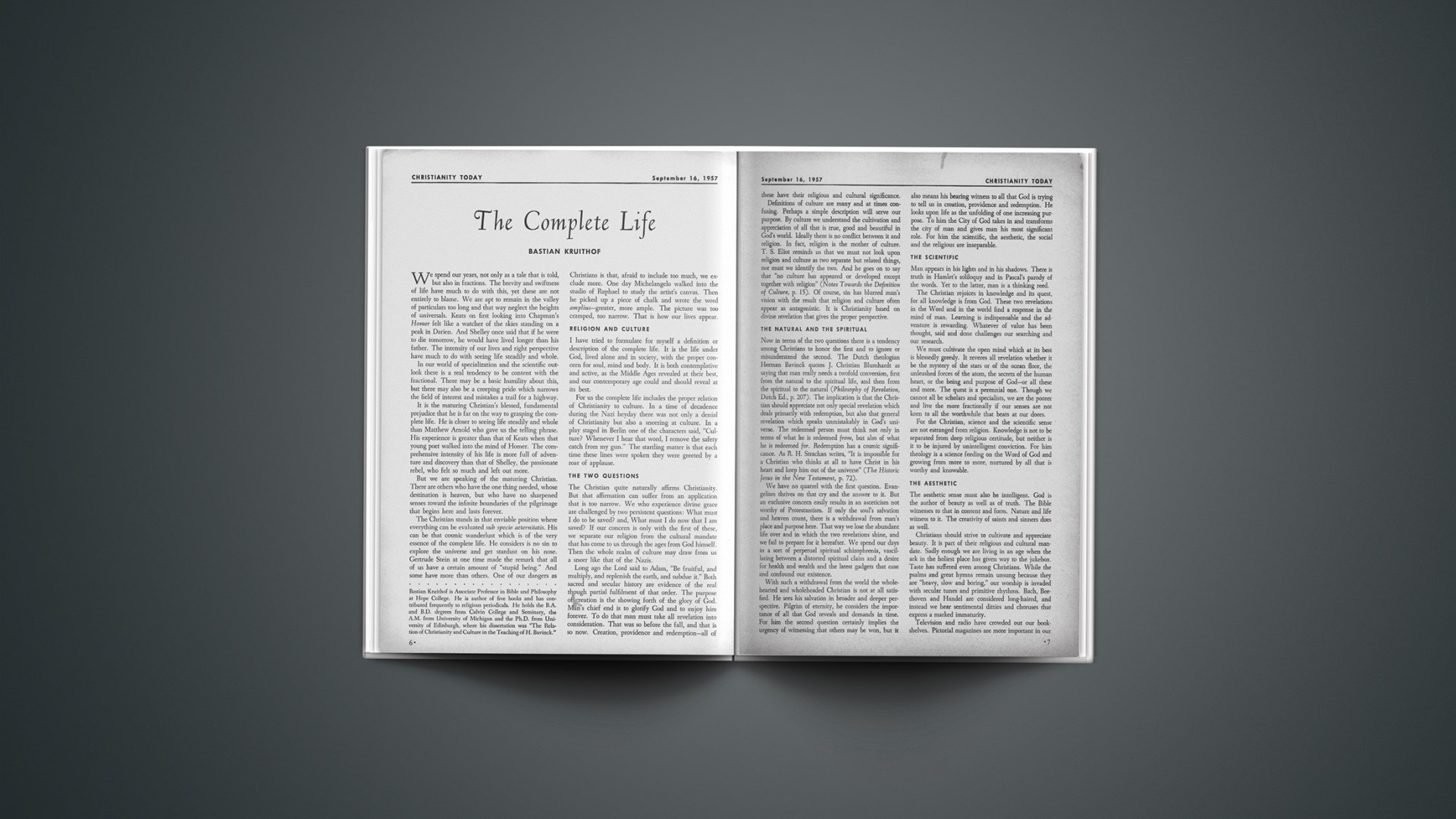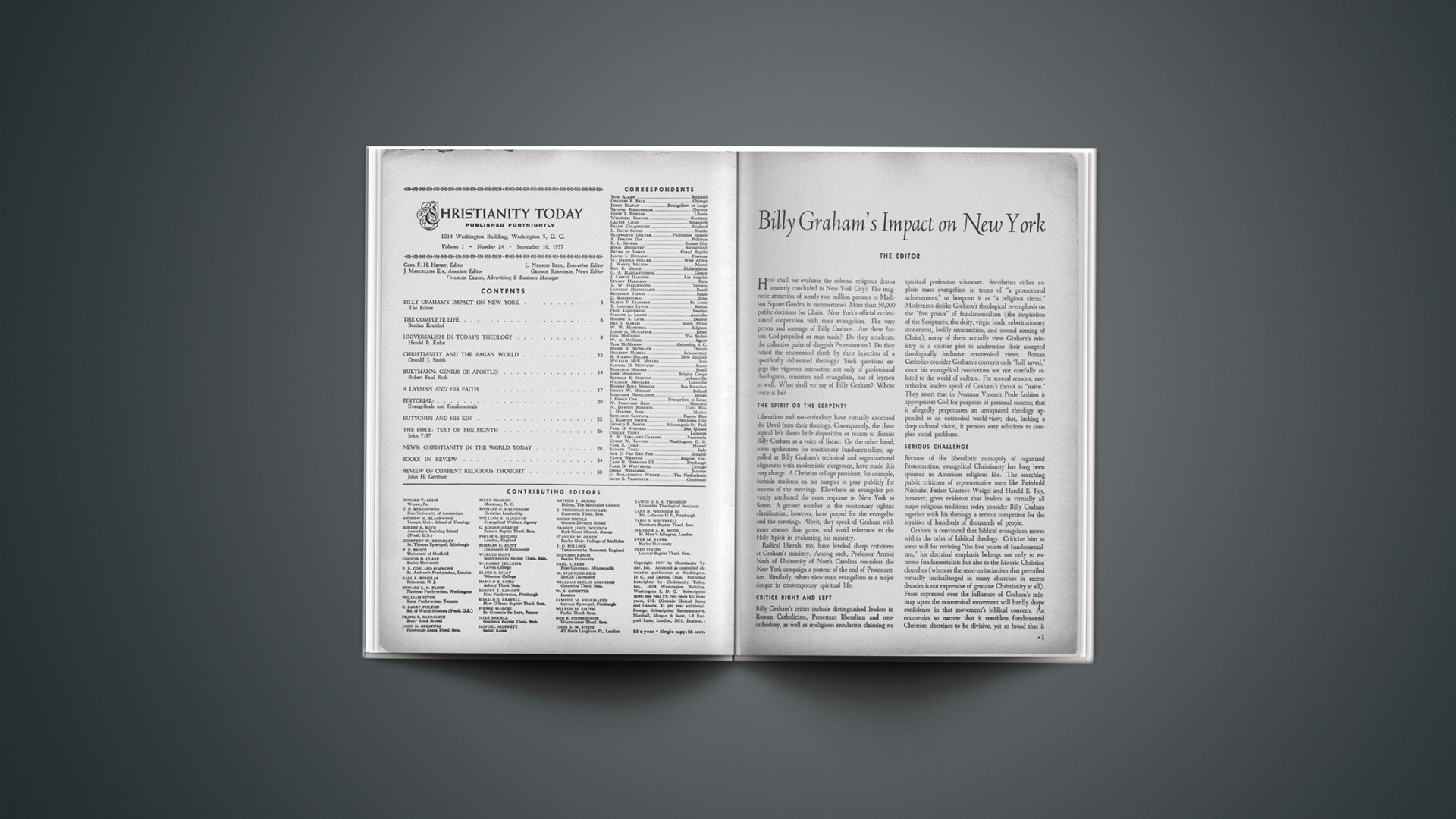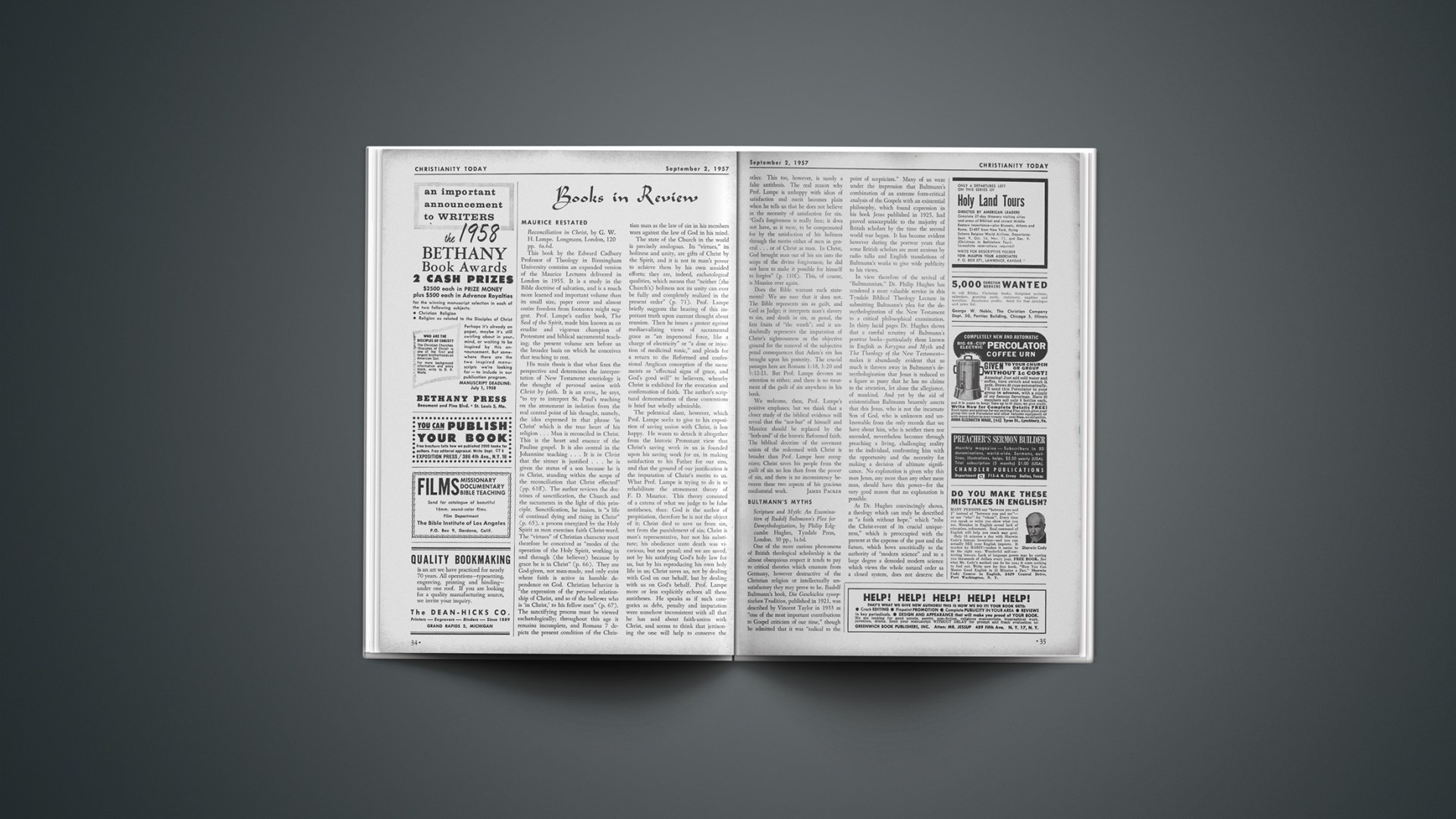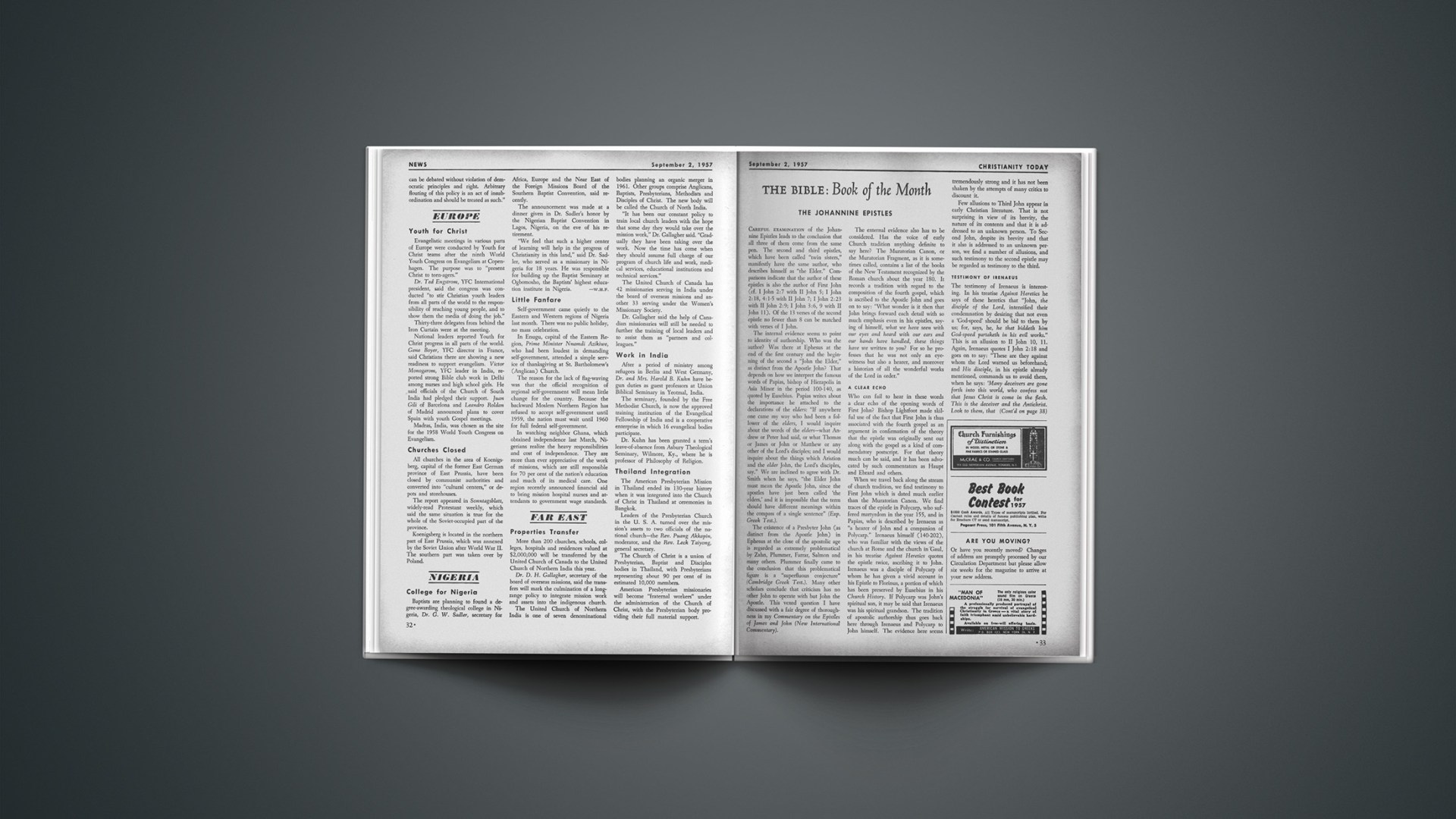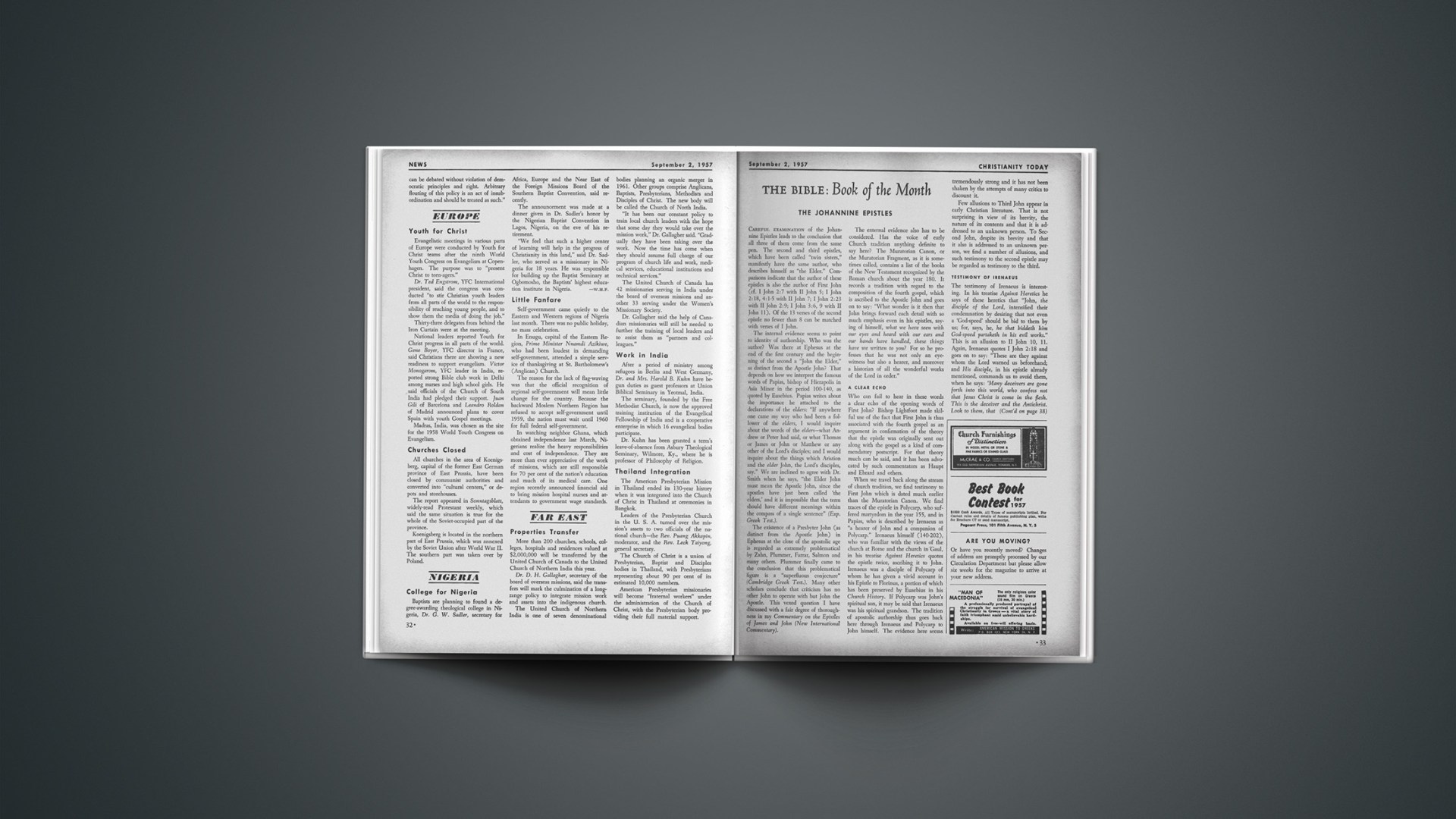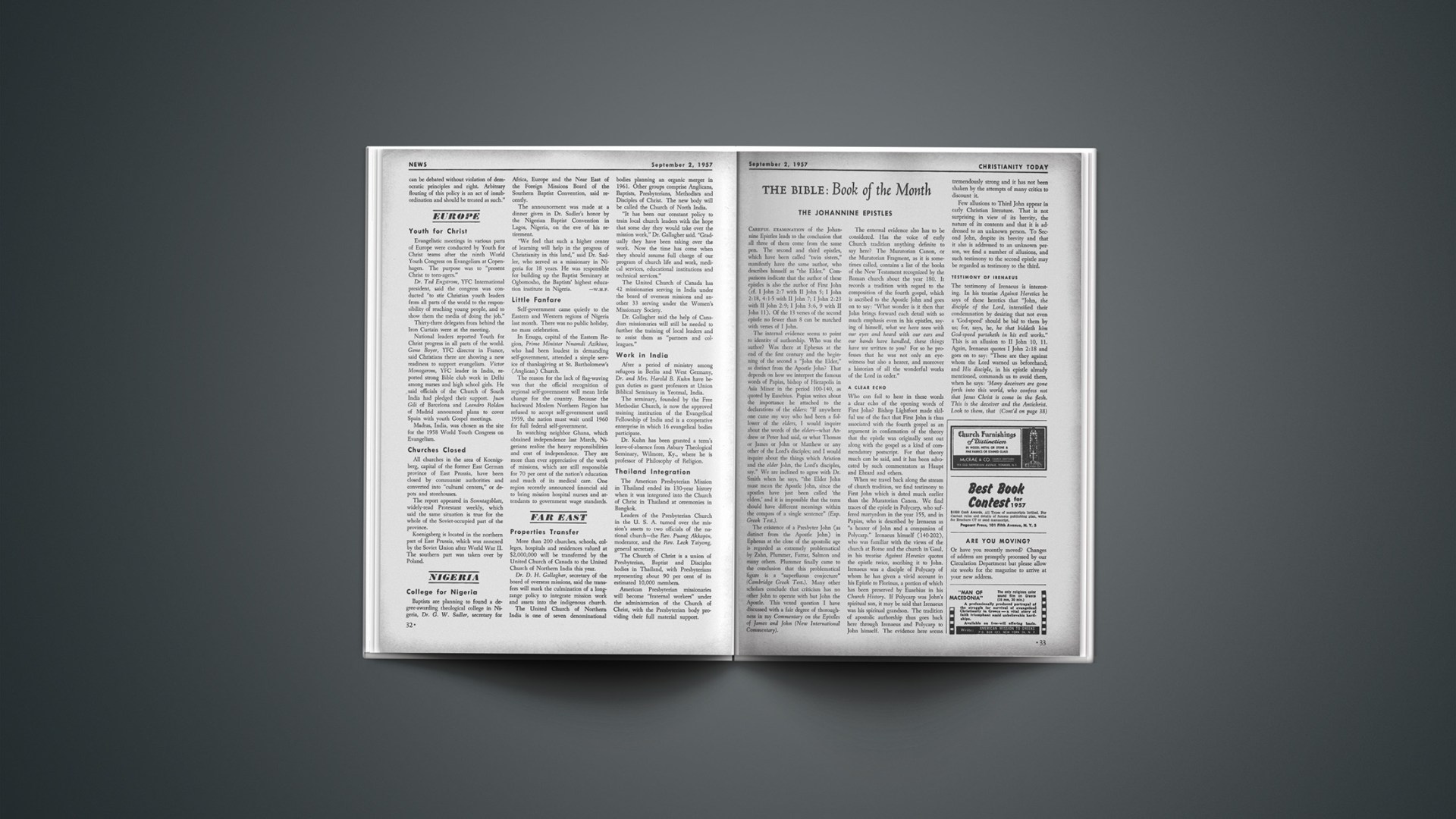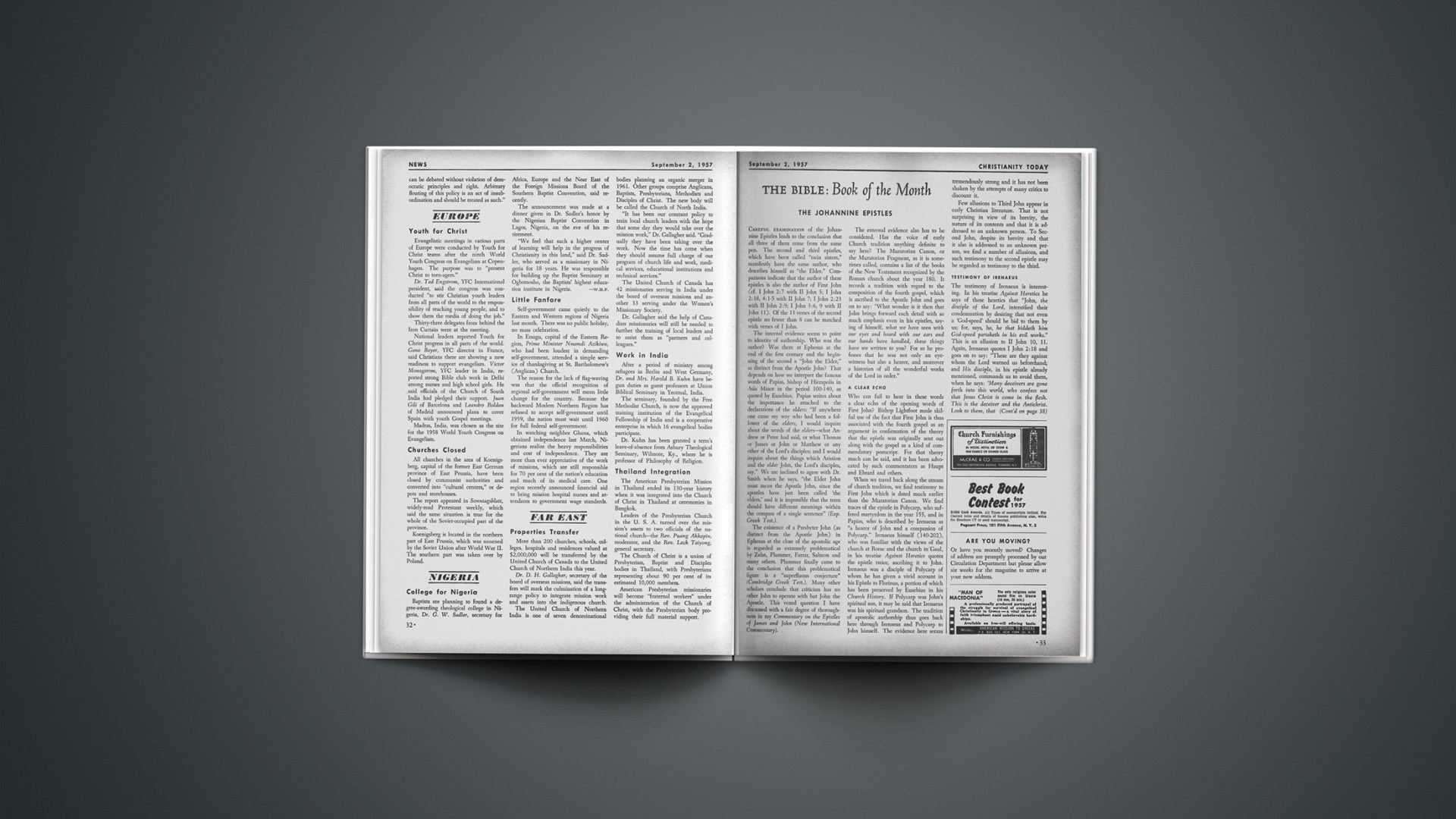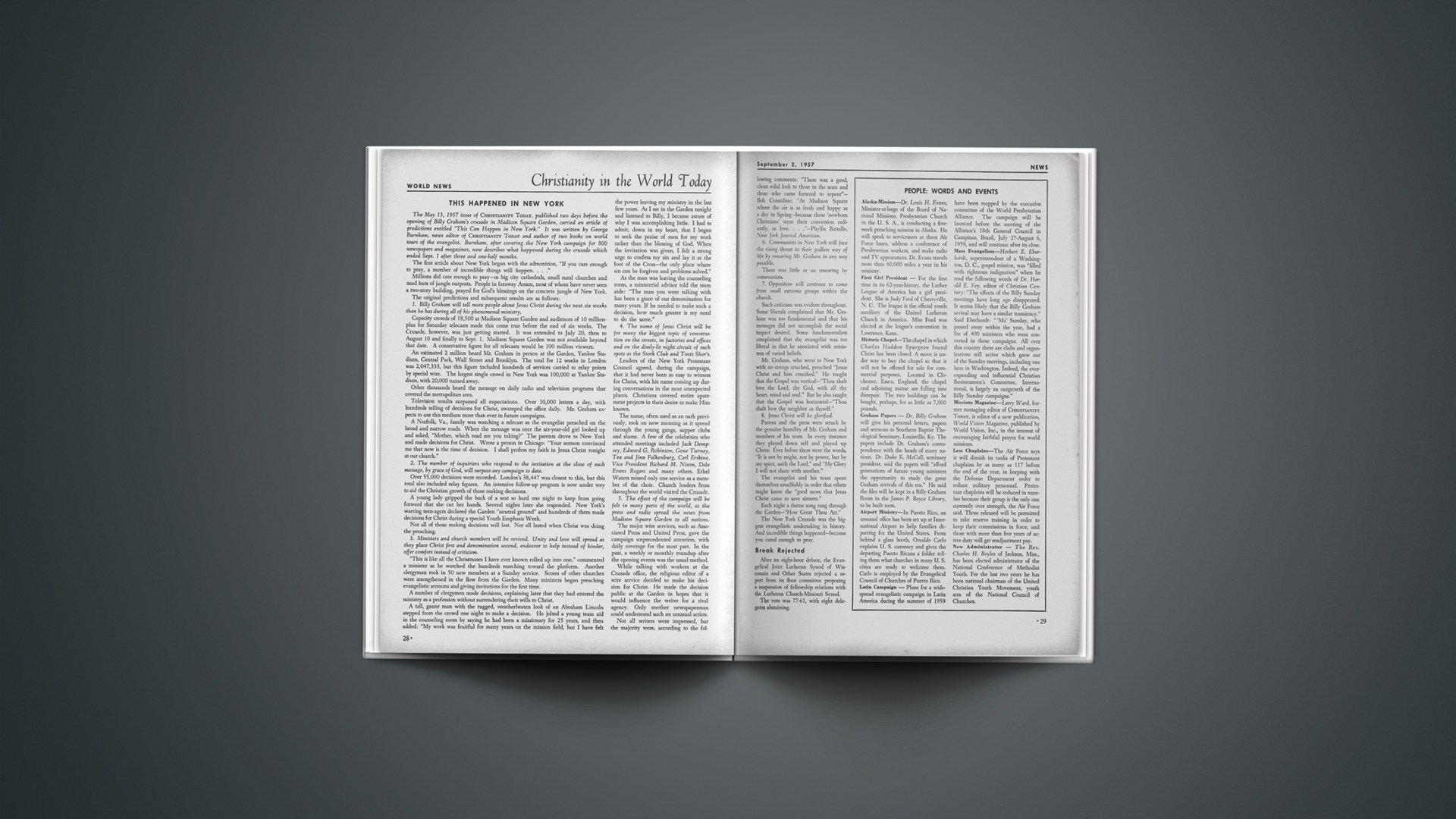We spend our years, not only as a tale that is told, but also in fractions. The brevity and swiftness of life have much to do with this, yet these are not entirely to blame. We are apt to remain in the valley of particulars too long and that way neglect the heights of universals. Keats on first looking into Chapman’s Homer felt like a watcher of the skies standing on a peak in Darien. And Shelley once said that if he were to die tomorrow, he would have lived longer than his father. The intensity of our lives and right perspective have much to do with seeing life steadily and whole.
In our world of specialization and the scientific outlook there is a real tendency to be content with the fractional. There may be a basic humility about this, but there may also be a creeping pride which narrows the field of interest and mistakes a trail for a highway.
It is the maturing Christian’s blessed, fundamental prejudice that he is far on the way to grasping the complete life. He is closer to seeing life steadily and whole than Matthew Arnold who gave us the telling phrase. His experience is greater than that of Keats when that young poet walked into the mind of Homer. The comprehensive intensity of his life is more full of adventure and discovery than that of Shelley, the passionate rebel, who felt so much and left out more.
But we are speaking of the maturing Christian. There are others who have the one thing needed, whose destination is heaven, but who have no sharpened senses toward the infinite boundaries of the pilgrimage that begins here and lasts forever.
The Christian stands in that enviable position where everything can be evaluated sub specie aeternitatis. His can be that cosmic wanderlust which is of the very essence of the complete life. He considers is no sin to explore the universe and get stardust on his nose. Gertrude Stein at one time made the remark that all of us have a certain amount of “stupid being.” And some have more than others. One of our dangers as Christians is that, afraid to include too much, we exclude more. One day Michelangelo walked into the studio of Raphael to study the artist’s canvas. Then he picked up a piece of chalk and wrote the word amplius—greater, more ample. The picture was too cramped, too narrow. That is how our lives appear.
Religion And Culture
I have tried to formulate for myself a definition or description of the complete life. It is the life under God, lived alone and in society, with the proper concern for soul, mind and body. It is both contemplative and active, as the Middle Ages revealed at their best, and our contemporary age could and should reveal at its best.
For us the complete life includes the proper relation of Christianity to culture. In a time of decadence during the Nazi heyday there was not only a denial of Christianity but also a sneering at culture. In a play staged in Berlin one of the characters said, “Culture? Whenever I hear that word, I remove the safety catch from my gun.” The startling matter is that each time these lines were spoken they were greeted by a roar of applause.
The Two Questions
The Christian quite naturally affirms Christianity. But that affirmation can suffer from an application that is too narrow. We who experience divine grace are challenged by two persistent questions: What must I do to be saved? and, What must I do now that I am saved? If our concern is only with the first of these, we separate our religion from the cultural mandate that has come to us through the ages from God himself. Then the whole realm of culture may draw from us a sneer like that of the Nazis.
Long ago the Lord said to Adam, “Be fruitful, and multiply, and replenish the earth, and subdue it.” Both sacred and secular history are evidence of the real though partial fulfillment of that order. The purpose of creation is the showing forth of the glory of God. Man’s chief end is to glorify God and to enjoy him forever. To do that man must take all revelation into consideration. That was so before the fall, and that is so now. Creation, providence and redemption—all of these have their religious and cultural significance.
Definitions of culture are many and at times confusing. Perhaps a simple description will serve our purpose. By culture we understand the cultivation and appreciation of all that is true, good and beautiful in God’s world. Ideally there is no conflict between it and religion. In fact, religion is the mother of culture. T. S. Eliot reminds us that we must not look upon religion and culture as two separate but related things, nor must we identify the two. And he goes on to say that “no culture has appeared or developed except together with religion” (Notes Towards the Definition of Culture, p. 15). Of course, sin has blurred man’s vision with the result that religion and culture often appear as antagonistic. It is Christianity based on divine revelation that gives the proper perspective.
The Natural And The Spiritual
Now in terms of the two questions there is a tendency among Christians to honor the first and to ignore or misunderstand the second. The Dutch theologian Herman Bavinck quotes J. Christian Blumhardt as saying that man really needs a twofold conversion, first from the natural to the spiritual life, and then from the spiritual to the natural (Philosophy of Revelation, Dutch Ed., p. 207). The implication is that the Christian should appreciate not only special revelation which deals primarily with redemption, but also that general revelation which speaks unmistakably in God’s universe. The redeemed person must think not only in terms of what he is redeemed from, but also of what he is redeemed for. Redemption has a cosmic significance. As R. H. Strachan writes, “It is impossible for a Christian who thinks at all to have Christ in his heart and keep him out of the universe” (The Historic Jesus in the New Testament, p. 72).
We have no quarrel with the first question. Evangelism thrives on that cry and the answer to it. But an exclusive concern easily results in an asceticism not worthy of Protestantism. If only the soul’s salvation and heaven count, there is a withdrawal from man’s place and purpose here. That way we lose the abundant life over and in which the two revelations shine, and we fail to prepare for it hereafter. We spend our days in a sort of perpetual spiritual schizophrenia, vascillating between a distorted spiritual claim and a desire for health and wealth and the latest gadgets that ease and confound our existence.
With such a withdrawal from the world the wholehearted and wholeheaded Christian is not at all satisfied. He sees his salvation in broader and deeper perspective. Pilgrim of eternity, he considers the importance of all that God reveals and demands in time. For him the second question certainly implies the urgency of witnessing that others may be won, but it also means his bearing witness to all that God is trying to tell us in creation, providence and redemption. He looks upon life as the unfolding of one increasing purpose. To him the City of God takes in and transforms the city of man and gives man his most significant role. For him the scientific, the aesthetic, the social and the religious are inseparable.
The Scientific
Man appears in his lights and in his shadows. There is truth in Hamlet’s soliloquy and in Pascal’s parody of the words. Yet to the latter, man is a thinking reed.
The Christian rejoices in knowledge and its quest, for all knowledge is from God. These two revelations in the Word and in the world find a response in the mind of man. Learning is indispensable and the adventure is rewarding. Whatever of value has been thought, said and done challenges our searching and our research.
We must cultivate the open mind which at its best is blessedly greedy. It reveres all revelation whether it be the mystery of the stars or of the ocean floor, the unleashed forces of the atom, the secrets of the human heart, or the being and purpose of God—or all these and more. The quest is a perennial one. Though we cannot all be scholars and specialists, we are the poorer and live the more fractionally if our senses are not keen to all the worthwhile that beats at our doors.
For the Christian, science and the scientific sense are not estranged from religion. Knowledge is not to be separated from deep religious certitude, but neither is it to be injured by unintelligent conviction. For him theology is a science feeding on the Word of God and growing from more to more, nurtured by all that is worthy and knowable.
The Aesthetic
The aesthetic sense must also be intelligent. God is the author of beauty as well as of truth. The Bible witnesses to that in content and form. Nature and life witness to it. The creativity of saints and sinners does as well.
Christians should strive to cultivate and appreciate beauty. It is part of their religious and cultural mandate. Sadly enough we are living in an age when the ark in the holiest place has given way to the jukebox. Taste has suffered even among Christians. While the psalms and great hymns remain unsung because they are “heavy, slow and boring,” our worship is invaded with secular tunes and primitive rhythms. Bach, Beethoven and Handel are considered long-haired, and instead we hear sentimental ditties and choruses that express a marked immaturity.
Television and radio have crowded out our bookshelves. Pictorial magazines are more important in our homes and hospitals than the living Word and books of value. If there is any reading, predigested digests curb our own spiritual and mental mastication. The heavens declare the glory of God and much on this good earth does the same, but we hurry through life with blinders, unmoved by the pre-education for eternity.
It is not entirely so. God pours out his beauty in nature and through poets, artists and musicians. One who has traveled remembers mountains, museums, music halls, cathedrals and libraries stocked with lore, more than eye and ear can grasp and the mind understand. All that beauty is for God to contemplate. The spillover is our reward until that greater comprehension unshackles our receptivity.
The Social
It was the divine will that man should not live alone. We have millions of brothers and sisters sprung from one common stock. The image of God in us, though sadly marred and needing restoration, makes for responsible relationship. I am more than my brother’s keeper; I am his brother. That implies privileges and duties in the family, society, the state and the world. Christianity gives us the shining ideals for each sphere. These cannot be spurned with impunity.
Christians basking in an atmosphere of, “When we all get to heaven,” are living very fractionally. If they lament the breakdown of the home, social delinquencies, labor disputes, separation from religion in education, economics and politics, and bitter race relations, they have also themselves to blame. For God requires of them that they love him above all and their neighbors as themselves. Their faith, wrapped in cellophane or hermetically sealed as insurance for the life to come, belies the words of Jesus that his followers must be the salt of the earth and the light of the world.
What Christian principles have done for all the social spheres is a long and astounding story. What they can and must still do is an adventurous chapter the denouement of which depends on how faithfully Christians will practice what they believe.
The Religious
Christian faith and practice are basic to the complete life. Christians are the children of God, the people of the Book, the beneficiaries of all divine revelation. The more sharpened our senses are to the ultimate values of life and to our calling in a world that bristles with problems, the more we answer to God’s purpose and will.
Personal piety, the assurance of salvation, a healthy walking with God, a profound theology of grace are essential. And a translation of these into dynamic action for the living of these days is indispensable. We must have the devotion of St. Augustine, the brotherliness of St. Francis, the heat of Luther, the burning heart of Calvin, the passion of John Wesley, the faith of our fathers, not dead but living.
Would you strive for the complete life? Then walk with God in the city streets, through alleys and on highways, in pastures and over mountains, in the atom and among the stars, in realms of duty and of beauty. And as you walk, keep your eyes on the City of God. That is the way of the complete life.
The Cathedral
Here it stands in humble eloquence,
The great cathedral, handsome, splendid, tall.
Across the street its morning shadows fall
As if to hide the sin and arrogance
Of foolish men, who by some plan or chance
Scorn heavenly things. But yet they heed the call
To worship in this great cathedral hall
And give its ornate walls a prideful glance.
They crowd its aisles, they listen to the choir,
And hear its echoes like a heavenly lyre.
Forgetting for the moment basic sin
They lose themselves to wandering thoughts within.
The temple bell rings solemnly from crypt to floor,
While Christ outside, waits lonely at the door!
Inspiration
He entered the cathedral timidly
As if its choir and chancel frowned on him
A stranger. But the soft and vibrant hymn
The organist was playing, seemed to be
A full processional—a melody
That caught his heart and cast aside his sin,
Making him guiltless, clean and pure within.
His life felt joyous, full, and free.
He found a seat among the silent crowd
Of worshippers, and in deep reverence bowed
His once proud head in strange humility,
As voices of the choir, in ecstasy,
Caught up the hymn in childhood he had known—
ABIDE WITH ME. He was with God, alone!
HARRY ALBERT MILLER

